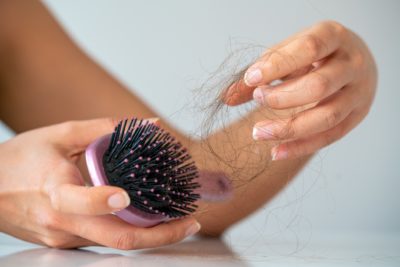Ladies, sad to say, but your gender doesn’t spare you the potential for partial  or total balding. Female hair loss can be a real problem. If it’s happening to you — even a little at a time — you probably want to shout, “No fair!” loud enough to make it stop!
or total balding. Female hair loss can be a real problem. If it’s happening to you — even a little at a time — you probably want to shout, “No fair!” loud enough to make it stop!
If only things were that simple. Then again, let’s not assume that a problem exists before digging in a little deeper. For example, it’s natural for you to lose between 50 and 100 hairs each day as old hair makes room for new, healthy hair. This process is completely normal and often goes unnoticed.
But if the rate of hair loss has you concerned – even if it’s within the range of normal – any of the following could be a factor.
Genetics. Hereditary hair loss in women is typically concentrated at the crown of the head, becoming especially noticeable along the hair part. While this type of hair loss is one that you can’t control or prevent entirely, early detection and treatment can slow the process and make hair appear fuller.
Childbirth. Most women notice rapid hair growth during pregnancy due to the surge of hormones. Once estrogen levels go back to normal, hair resumes its natural cycle and starts to shed the hair that has accumulated over the previous 9 months. This type of hair loss is called telogen effluvium and can occur after any major life event. The good news is – it’s a temporary condition.
Birth Control. Stopping, starting, or changing hormonal contraception can cause hair to shed at a faster clip. Again, once hormone levels return to normal, the excessive shedding should subside.
Nutritional Deficiency. Individuals who aren’t getting enough zinc, iron, protein, and vitamin B3 in their diets may experience greater-than-normal hair loss. Ask your doctor to have blood work done so you can confirm or erase the possibility.
Medications. Certain medications, like those used to treat cancer and manage arthritis, high blood pressure, and depression, can cause chronic hair shedding. If you think your medication may be the culprit, consult your doctor. Sometimes an alternative can be prescribed that doesn’t include this side effect.
Stress or Trauma. Life altering experiences such as a divorce, death of a loved one, hospitalization, etc., can cause hair to stop growing temporarily as your body focuses on getting through this stressful time. Once your emotional recovery kicks into gear, the hair loss problem should go away on its own.
Hairstyles. Traction alopecia occurs when hair is repeatedly pulled, like in a tight braid or ponytail. It results in a thinning of the hairline over time and can become permanent if the hair follicles are severely damaged. Avoid hairstyles that pull your hair and choose scrunchies over elastic bands.
Over-styling. Thermal damage to hair from frequent heat styling, repeated use of harsh chemicals, coloring, chemical straightening, relaxing, or curling, and even aggressive brushing can damage hair shafts and cause hair to break easily. Prevent damage by taking breaks from over-styling, use more gentle haircare techniques, and choose soothing hair products that hydrate and protect the hair and scalp.
Only you know what constitutes an acceptable level of hair loss. So, if your patience is gone and your brush more choked with hair than ever, it’s time to schedule a free consultation with DiStefano Hair Restoration Center. We are experienced with treating women’s hair loss — and with five locations in Southern New England, we’re bound to be close by.


